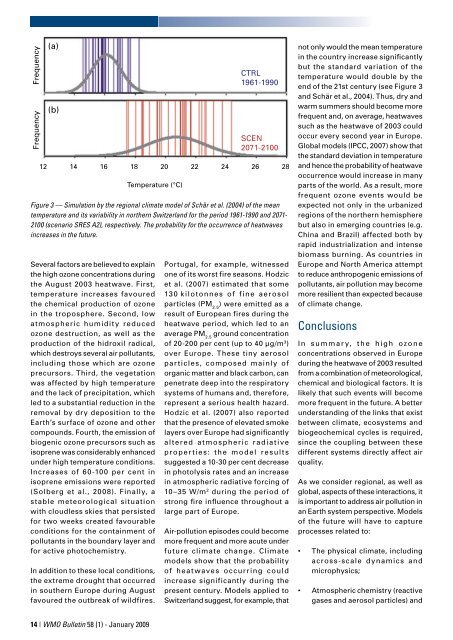Weather, climate and the air we breathe - WMO
Weather, climate and the air we breathe - WMO
Weather, climate and the air we breathe - WMO
Create successful ePaper yourself
Turn your PDF publications into a flip-book with our unique Google optimized e-Paper software.
Frequency<br />
Frequency<br />
(a)<br />
(b)<br />
RCM simulations for nor<strong>the</strong>rn Switzerl<strong>and</strong><br />
12 14 16 18 20 22 24 26 28<br />
Several factors are believed to explain<br />
<strong>the</strong> high ozone concentrations during<br />
<strong>the</strong> August 2003 heatwave. First,<br />
temperature increases favoured<br />
<strong>the</strong> chemical production of ozone<br />
in <strong>the</strong> troposphere. Second, low<br />
atmospheric humidity reduced<br />
ozone destruction, as <strong>we</strong>ll as <strong>the</strong><br />
production of <strong>the</strong> hidroxil radical,<br />
which destroys several <strong>air</strong> pollutants,<br />
including those which are ozone<br />
precursors. Third, <strong>the</strong> vegetation<br />
was affected by high temperature<br />
<strong>and</strong> <strong>the</strong> lack of precipitation, which<br />
led to a substantial reduction in <strong>the</strong><br />
removal by dry deposition to <strong>the</strong><br />
Earth’s surface of ozone <strong>and</strong> o<strong>the</strong>r<br />
compounds. Fourth, <strong>the</strong> emission of<br />
biogenic ozone precursors such as<br />
isoprene was considerably enhanced<br />
under high temperature conditions.<br />
Increases of 60-100 per cent in<br />
isoprene emissions <strong>we</strong>re reported<br />
(Solberg et al., 2008). Finally, a<br />
stable meteorological situation<br />
with cloudless skies that persisted<br />
for two <strong>we</strong>eks created favourable<br />
conditions for <strong>the</strong> containment of<br />
pollutants in <strong>the</strong> boundary layer <strong>and</strong><br />
for active photochemistry.<br />
In addition to <strong>the</strong>se local conditions,<br />
<strong>the</strong> extreme drought that occurred<br />
in sou<strong>the</strong>rn Europe during August<br />
favoured <strong>the</strong> outbreak of wildfires.<br />
1 | <strong>WMO</strong> Bulletin 58 (1) - January 2009<br />
Temperature (°C)<br />
CTRL<br />
1961-1990<br />
SCEN<br />
2071-2100<br />
Figure 3 — Simulation by <strong>the</strong> regional <strong>climate</strong> model of Schär et al. (2004) of <strong>the</strong> mean<br />
temperature <strong>and</strong> its variability in nor<strong>the</strong>rn Switzerl<strong>and</strong> for <strong>the</strong> period 1961-1990 <strong>and</strong> 2071-<br />
2100 (scenario SRES A2), respectively. The probability for <strong>the</strong> occurrence of heatwaves<br />
increases in <strong>the</strong> future.<br />
Portugal, for example, witnessed<br />
one of its worst fire seasons. Hodzic<br />
et al. (2007) estimated that some<br />
130 kilotonnes of fine aerosol<br />
particles (PM 2.5 ) <strong>we</strong>re emitted as a<br />
result of European fires during <strong>the</strong><br />
heatwave period, which led to an<br />
average PM 2.5 ground concentration<br />
of 20-200 per cent (up to 40 μg/m 3 )<br />
over Europe. These tiny aerosol<br />
particles, composed mainly of<br />
organic matter <strong>and</strong> black carbon, can<br />
penetrate deep into <strong>the</strong> respiratory<br />
systems of humans <strong>and</strong>, <strong>the</strong>refore,<br />
represent a serious health hazard.<br />
Hodzic et al. (2007) also reported<br />
that <strong>the</strong> presence of elevated smoke<br />
layers over Europe had significantly<br />
altered atmospheric radiative<br />
properties: <strong>the</strong> model results<br />
suggested a 10-30 per cent decrease<br />
in photolysis rates <strong>and</strong> an increase<br />
in atmospheric radiative forcing of<br />
10–35 W/m 2 during <strong>the</strong> period of<br />
strong fire influence throughout a<br />
large part of Europe.<br />
Air-pollution episodes could become<br />
more frequent <strong>and</strong> more acute under<br />
future <strong>climate</strong> change. Climate<br />
models show that <strong>the</strong> probability<br />
of heatwaves occurring could<br />
increase significantly during <strong>the</strong><br />
present century. Models applied to<br />
Switzerl<strong>and</strong> suggest, for example, that<br />
not only would <strong>the</strong> mean temperature<br />
in <strong>the</strong> country increase significantly<br />
but <strong>the</strong> st<strong>and</strong>ard variation of <strong>the</strong><br />
temperature would double by <strong>the</strong><br />
end of <strong>the</strong> 21st century (see Figure 3<br />
<strong>and</strong> Schär et al., 2004). Thus, dry <strong>and</strong><br />
warm summers should become more<br />
frequent <strong>and</strong>, on average, heatwaves<br />
such as <strong>the</strong> heatwave of 2003 could<br />
occur every second year in Europe.<br />
Global models (IPCC, 2007) show that<br />
<strong>the</strong> st<strong>and</strong>ard deviation in temperature<br />
<strong>and</strong> hence <strong>the</strong> probability of heatwave<br />
occurrence would increase in many<br />
parts of <strong>the</strong> world. As a result, more<br />
frequent ozone events would be<br />
expected not only in <strong>the</strong> urbanized<br />
regions of <strong>the</strong> nor<strong>the</strong>rn hemisphere<br />
but also in emerging countries (e.g.<br />
China <strong>and</strong> Brazil) affected both by<br />
rapid industrialization <strong>and</strong> intense<br />
biomass burning. As countries in<br />
Europe <strong>and</strong> North America attempt<br />
to reduce anthropogenic emissions of<br />
pollutants, <strong>air</strong> pollution may become<br />
more resilient than expected because<br />
of <strong>climate</strong> change.<br />
Conclusions<br />
In summary, <strong>the</strong> high ozone<br />
concentrations observed in Europe<br />
during <strong>the</strong> heatwave of 2003 resulted<br />
from a combination of meteorological,<br />
chemical <strong>and</strong> biological factors. It is<br />
likely that such events will become<br />
more frequent in <strong>the</strong> future. A better<br />
underst<strong>and</strong>ing of <strong>the</strong> links that exist<br />
bet<strong>we</strong>en <strong>climate</strong>, ecosystems <strong>and</strong><br />
biogeochemical cycles is required,<br />
since <strong>the</strong> coupling bet<strong>we</strong>en <strong>the</strong>se<br />
different systems directly affect <strong>air</strong><br />
quality.<br />
As <strong>we</strong> consider regional, as <strong>we</strong>ll as<br />
global, aspects of <strong>the</strong>se interactions, it<br />
is important to address <strong>air</strong> pollution in<br />
an Earth system perspective. Models<br />
of <strong>the</strong> future will have to capture<br />
processes related to:<br />
•<br />
•<br />
The physical <strong>climate</strong>, including<br />
across-scale dynamics <strong>and</strong><br />
microphysics;<br />
Atmospheric chemistry (reactive<br />
gases <strong>and</strong> aerosol particles) <strong>and</strong>

















